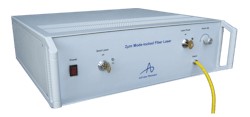AdValue Photonics high-power fiber laser provides near-diffraction-limited beam
This high-power, mode-locked fiber laser in the 2 µm spectral region features >10 kW peak power, picosecond pulses, 1 W average power, and a near-diffraction-limited beam. It is suited for mid-IR generation, nonlinear frequency conversion, spectroscopy, sensing, and materials processing investigations.
AdValue Photonics
Tucson, AZ
[email protected]
-----
PRESS RELEASE
2µm mode-locked fiber laser provides high peak power for mid-IR wavelength generation
Developed by AdValue Photonics, the world’s first High Power Mode-Locked Fiber Laser in the 2 micron spectral region with >10 kW peak power, picosecond pulses, 1W average power, and near diffraction limited beam offers unprecedented capabilities to the scientific communities for mid-infrared generation, nonlinear frequency conversion, spectroscopy, sensing, and materials processing investigations. Such a laser source requires very special expertise to build and a commercial solution was non-existent. The availability of the AdValue Photonics’ new product provides the needed performance capability with the convenience of a turn-key system and a compact size. As a fiber-based system, it is also highly reliable and maintenance free.
Commercially available mode-locked fiber lasers at the current time operate in the near-infrared region, such as Yb-doped fiber lasers at 1 micron and Er-doped fiber lasers at 1.55 micron. AdValue Photonics has extended the wavelength capability of mode-locked fiber lasers into the mid-infrared (mid-IR) spectral region of 2 micron. At the same time, 2 micron is a very efficient pump wavelength for frequency conversion into the longer wavelengths of the mid-IR spectral region such as 3 to 5 micron. The high power mode-locked fiber laser plays an important role in this area due to its high beam intensity that is the direct driving force for efficient nonlinear effects in materials; and optical nonlinear effects are often the mechanism used to generate mid-IR sources. Applications in mid-IR region include infrared countermeasures, thermal imaging, trace-gas sensing, industrial process controls, hazardous chemical detection, materials processing, laser surgeries, medical diagnostics, etc.
